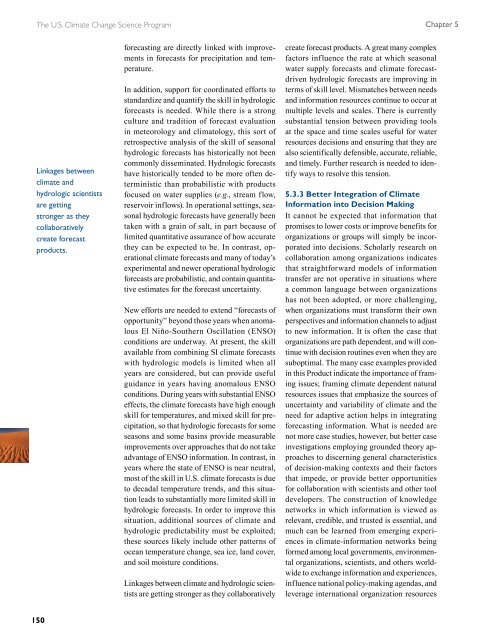Decision support experiments and evaluations using seasonal to ...
Decision support experiments and evaluations using seasonal to ...
Decision support experiments and evaluations using seasonal to ...
Create successful ePaper yourself
Turn your PDF publications into a flip-book with our unique Google optimized e-Paper software.
The U.S. Climate Change Science Program<br />
Linkages between<br />
climate <strong>and</strong><br />
hydrologic scientists<br />
are getting<br />
stronger as they<br />
collaboratively<br />
create forecast<br />
products.<br />
150<br />
forecasting are directly linked with improvements<br />
in forecasts for precipitation <strong>and</strong> temperature.<br />
In addition, <strong>support</strong> for coordinated efforts <strong>to</strong><br />
st<strong>and</strong>ardize <strong>and</strong> quantify the skill in hydrologic<br />
forecasts is needed. While there is a strong<br />
culture <strong>and</strong> tradition of forecast evaluation<br />
in meteorology <strong>and</strong> clima<strong>to</strong>logy, this sort of<br />
retrospective analysis of the skill of <strong>seasonal</strong><br />
hydrologic forecasts has his<strong>to</strong>rically not been<br />
commonly disseminated. Hydrologic forecasts<br />
have his<strong>to</strong>rically tended <strong>to</strong> be more often deterministic<br />
than probabilistic with products<br />
focused on water supplies (e.g., stream flow,<br />
reservoir inflows). In operational settings, <strong>seasonal</strong><br />
hydrologic forecasts have generally been<br />
taken with a grain of salt, in part because of<br />
limited quantitative assurance of how accurate<br />
they can be expected <strong>to</strong> be. In contrast, operational<br />
climate forecasts <strong>and</strong> many of <strong>to</strong>day’s<br />
experimental <strong>and</strong> newer operational hydrologic<br />
forecasts are probabilistic, <strong>and</strong> contain quantitative<br />
estimates for the forecast uncertainty.<br />
New efforts are needed <strong>to</strong> extend “forecasts of<br />
opportunity” beyond those years when anomalous<br />
El Niño-Southern Oscillation (ENSO)<br />
conditions are underway. At present, the skill<br />
available from combining SI climate forecasts<br />
with hydrologic models is limited when all<br />
years are considered, but can provide useful<br />
guidance in years having anomalous ENSO<br />
conditions. During years with substantial ENSO<br />
effects, the climate forecasts have high enough<br />
skill for temperatures, <strong>and</strong> mixed skill for precipitation,<br />
so that hydrologic forecasts for some<br />
seasons <strong>and</strong> some basins provide measurable<br />
improvements over approaches that do not take<br />
advantage of ENSO information. In contrast, in<br />
years where the state of ENSO is near neutral,<br />
most of the skill in U.S. climate forecasts is due<br />
<strong>to</strong> decadal temperature trends, <strong>and</strong> this situation<br />
leads <strong>to</strong> substantially more limited skill in<br />
hydrologic forecasts. In order <strong>to</strong> improve this<br />
situation, additional sources of climate <strong>and</strong><br />
hydrologic predictability must be exploited;<br />
these sources likely include other patterns of<br />
ocean temperature change, sea ice, l<strong>and</strong> cover,<br />
<strong>and</strong> soil moisture conditions.<br />
Linkages between climate <strong>and</strong> hydrologic scientists<br />
are getting stronger as they collaboratively<br />
create forecast products. A great many complex<br />
fac<strong>to</strong>rs influence the rate at which <strong>seasonal</strong><br />
water supply forecasts <strong>and</strong> climate forecastdriven<br />
hydrologic forecasts are improving in<br />
terms of skill level. Mismatches between needs<br />
<strong>and</strong> information resources continue <strong>to</strong> occur at<br />
multiple levels <strong>and</strong> scales. There is currently<br />
substantial tension between providing <strong>to</strong>ols<br />
at the space <strong>and</strong> time scales useful for water<br />
resources decisions <strong>and</strong> ensuring that they are<br />
also scientifically defensible, accurate, reliable,<br />
<strong>and</strong> timely. Further research is needed <strong>to</strong> identify<br />
ways <strong>to</strong> resolve this tension.<br />
5.3.3 Better Integration of Climate<br />
Information in<strong>to</strong> <strong>Decision</strong> Making<br />
It cannot be expected that information that<br />
promises <strong>to</strong> lower costs or improve benefits for<br />
organizations or groups will simply be incorporated<br />
in<strong>to</strong> decisions. Scholarly research on<br />
collaboration among organizations indicates<br />
that straightforward models of information<br />
transfer are not operative in situations where<br />
a common language between organizations<br />
has not been adopted, or more challenging,<br />
when organizations must transform their own<br />
perspectives <strong>and</strong> information channels <strong>to</strong> adjust<br />
<strong>to</strong> new information. It is often the case that<br />
organizations are path dependent, <strong>and</strong> will continue<br />
with decision routines even when they are<br />
suboptimal. The many case examples provided<br />
in this Product indicate the importance of framing<br />
issues; framing climate dependent natural<br />
resources issues that emphasize the sources of<br />
uncertainty <strong>and</strong> variability of climate <strong>and</strong> the<br />
need for adaptive action helps in integrating<br />
forecasting information. What is needed are<br />
not more case studies, however, but better case<br />
investigations employing grounded theory approaches<br />
<strong>to</strong> discerning general characteristics<br />
of decision-making contexts <strong>and</strong> their fac<strong>to</strong>rs<br />
that impede, or provide better opportunities<br />
for collaboration with scientists <strong>and</strong> other <strong>to</strong>ol<br />
developers. The construction of knowledge<br />
networks in which information is viewed as<br />
relevant, credible, <strong>and</strong> trusted is essential, <strong>and</strong><br />
much can be learned from emerging experiences<br />
in climate-information networks being<br />
formed among local governments, environmental<br />
organizations, scientists, <strong>and</strong> others worldwide<br />
<strong>to</strong> exchange information <strong>and</strong> experiences,<br />
influence national policy-making agendas, <strong>and</strong><br />
leverage international organization resources<br />
Chapter 5




